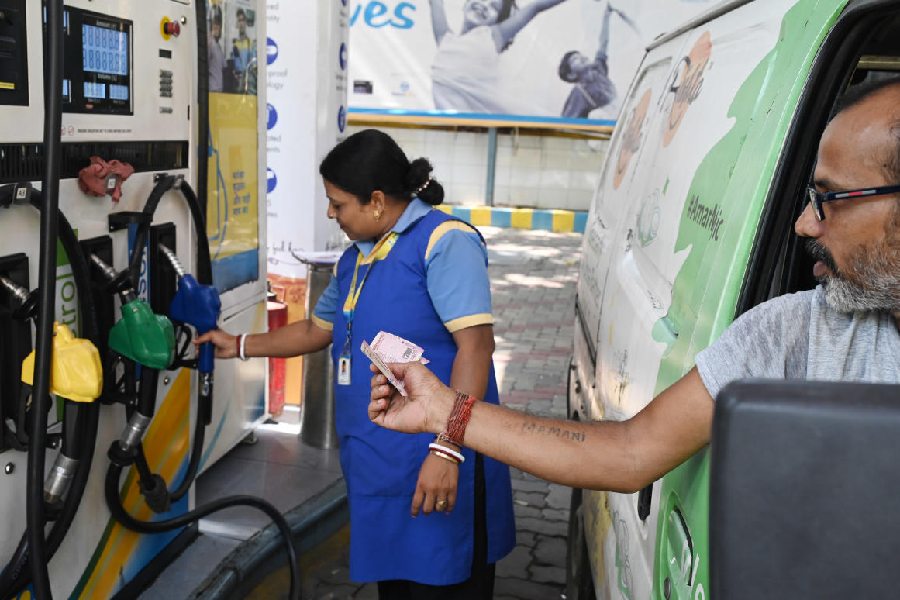A fuel pump near AJC Bose Road, one of the busiest in the city, usually gets between 50 and 60 notes of Rs 2,000 in 24 hours.
On Saturday, the collection was more than 100 notes till just 2pm. The pump is open round the clock and two shifts of business were still remaining.
On a much smaller scale, a grocer in Gariahat got five notes of Rs 2,000 between Saturday morning and noon. Usually, he gets no more than one a day.
A day after the Reserve Bank of India’s announcement to withdraw the Rs 2,000 notes, there was tangible urgency to do away with the highest-denomination note currently in circulation.
The urgency was, however, nothing compared to what the city witnessed in the wake of the demonetisation in November 2016.
Around 3pm, the pump at the intersection of Theatre Road and AJC Bose Road was busy as usual.
In the 25-odd minutes that The Telegraph spent there, the Rs 2,000 note popped out of the hand of drivers at least twice.
The pump, owned and operated by a PSU oil firm, is open 24X7 and handles more than 4,000 vehicles every day, said Sibsankar Adak, a staff in the office of the pump.
“Usually, we get between 50 to 60 Rs 2,000 notes in a day. But today, we have received 103 such notes in the first shift (6am to 2pm) alone,” Adak told this newspaper.
Biswajit Saha, the owner of Laxmi Narayan Stores on Hindusthan Road, had not received a single Rs 2,000 note till 10.30am. But between 10.30am and 2pm, he received five.
“None of the customers bought stuff worth more than Rs 500. But they said they did not have change,” said Saha.
He is counting on some more such notes on Sunday and plans to visit the bank to deposit the money on Monday.
The RBI said that holders of the notes, which have not been printed since 2018-19, would be able to exchange them at bank still September 30.
For now, they will still be legal tender — which means that they can technically be used to buy goods and services.
But with the guillotine having already fallen, it remains to be seen if shopkeepers accept the notes in the coming days.
Saturday, being the third of this month, was a working day at banks. But the rush of depositing Rs 2,000 notes was yet to pick up, suggested accounts from several places.
An official of a private bank’s Jadavpur branch said nine Rs 2,000 notes were deposited on Saturday, compared to the usual daily average which he put at “less than five”.
The manager of a PSU bank in Dalhousie said the branch received “around 50” notes of Rs 2,000 on Saturday. But it was not unusual for a branch in the business hub of Kolkata, he said.
The Rs 2,000 note — introduced soon after the November 2016 demonetisation — had almost disappeared from circulation for quite some time now. ATMS had also stopped dispensing them.
Following the announcement, they seemed to have re-emerged.
Pratap Daryanani, the owner of Oasis, a bar-cum-restaurant on Park Street, said he received “around four” notes of Rs 2,000 during lunch hours on Saturday.
“The note had almost vanished. More than 90 per cent of my transactions are now cashless. I don’t see a major change in that but I got Rs 2,000 notes in bills after some time,” he said.
Not all businesses have a similar story to tell. A bath accessories store in south Kolkata said more than half of its business was still in cash.
A family in Parnasree rented a car to visit an ailing relative in Durgapur on Saturday. They were carrying two Rs 2,000 notes to pay the toll. But the car had a FASTag and the money was debited digitally.
“We spent one of the notes at a dhaba where we had stopped for breakfast,” said Amiya Das, 48, who went to Durgapur with his wife, sister and nephew.
